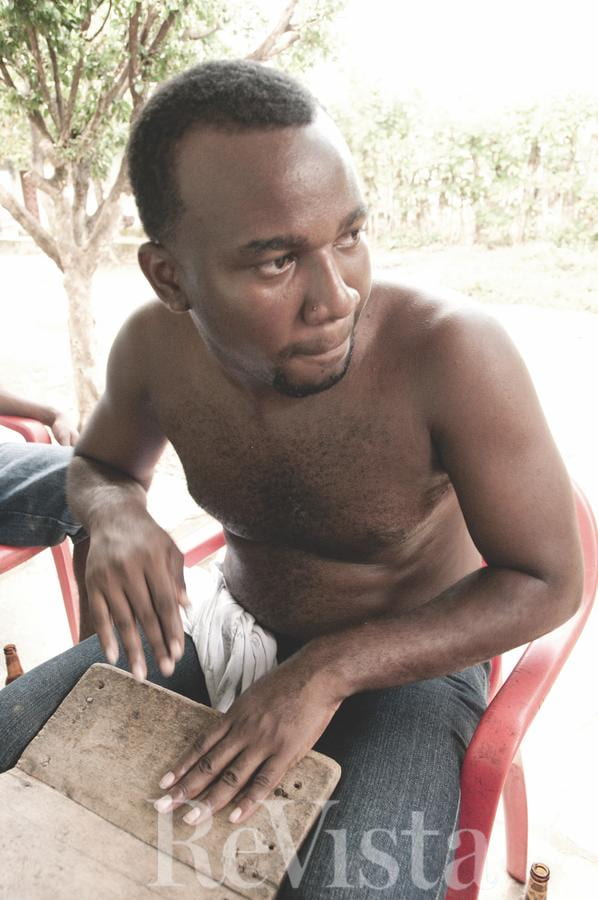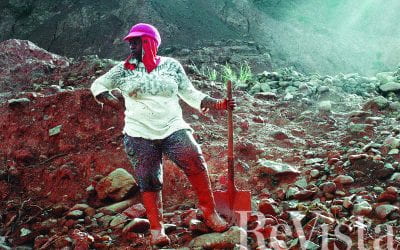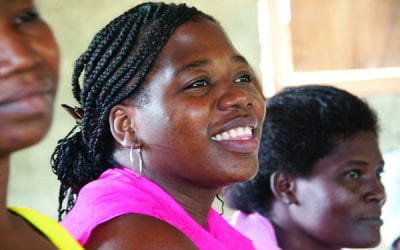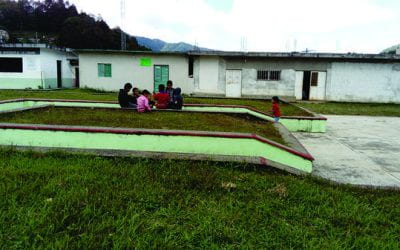La Candela Viva
Igniting Musical Connections in Palenque de San Basilio, Colombia
The drumbeat is the pulse of Palenque de San Basilio; it is central to birth, death, marriage and other celebrations. In this Colombian town, drumming is about communion and connection: with the ancestors, spirit-energies, dancers and singers. Rafael Cassiani Cassiani, one of the town’s most legendary musicians, af rms this strong connection. He is in the patio of his home, sitting atop his marímbula, a rectangular box instrument with metal keys that he explains came to Palenque from Cuba. Smiling, he eagerly awaits guests to whom he will explain the significance of music in his life and the living history that he embodies.
I am one such guest, part of a tourist group of professors and scholars of Latin America who are taking an organized tour of Palenque (also called San Basilio de Palenque), said to be the oldest surviving free community established by runaway slaves in the Americas. It was founded in the early 17th century by enslaved peoples who fled from Cartagena de Indias, one of the largest slave entrepots in Spanish America. Our tour, like many tours here, is organized with the close cooperation of community members. One of them met us in Cartagena, sharing the history of Palenque with us en route to the town. By the time we arrived, we had learned of the social structures, local agriculture, religion, the Bantú-derived Palenquero language and the importance of musical heritage.
We stepped down from our tour bus into the central plaza of the town, dominated by a tall statue of Benkos Bioho, the runaway slave warrior who founded the community. The statue is a reminder of the long history of black resistance in Colombia and the liberation achieved by Bioho. His power and strength are evident in his posture and expression, rising out of the column that lifts the statue into the air far above human height. His hands, the right lifting beyond his body, show where chains were around the wrists. Bioho, known as Domingo in the Americas, was said to be an African king who came from the Bioho region of what is today Guinea-Bissau. He fled Spanish colonial slavery with his family, and established Palenque. As Colombian anthropologist Nina S. de Friedemann asserted in one of the rst cultural studies of Palenque, Ma Ngombe: guerreros y ganaderos in Palenque (1979), the name Benkos Bioho has come to symbolize the spirit of rebellion.
Due to its maroon community heritage, Palenque has traditionally been portrayed in terms of its relative isolation and insularity. Its separation from mainstream Colombian culture and preservation of long-held traditions are celebrated locally, nationally, and more recently, internationally. UNESCO named the town a site of Intangible Cultural Heritage of Humanity in 2010. Yet Palenqueros have long contributed to Colombian society more broadly; music—as well as sports (it is the birthplace of three world champion boxers)—has been an essential conduit of connection. In the following three examples, Palenque’s musical engagement in a wider, African diasporic community is visible. I follow the lead of historian Kim Butler, who claims that the unique relationships forged between members of the African diaspora and their communities, including across generations, are a fundamental aspect of the diasporic experience and process. The first is an example of outsiders coming in, the last two represent moments of Palenqueros reaching out, bringing their music to wider national and international audiences.
Ha llegado el habanero, Ha llegado el palenquero
—from “Chí Chí Maní,” Totó la momposina
The Sexteto Tabalá celebrated ninety years of creating music this year. Members have come and gone from the group, but Rafael Cassiani has been one of the most consistent across the decades. He joined the group as a child in the 1930s. When he spoke to our tour group about the Sexteto’s history, he repeatedly emphasized how influential Cuban culture has been to the group. This is surprising, given that Palenque is understood to have a rich musical tradition that has been relatively untouched, untainted, and more “African” than other musical styles. Yet the Palenque Sextetos were the result of intercultural collaboration.
Cuban sugar workers arrived from the island in the first decade of the 20th century to work in the Central Colombia Sugar Mill, located in Sincerín on the Canal del Dique near Mahates. Some of these workers settled in Palenque; others met Palenqueros who worked in the mill. Their proximity fostered a cultural exchange that resulted in Palenque’s adoption of Cuban son, a musical style based in African-derived rhythms and the use of the marímbula; the instrument upon which Rafael Cassiani was sitting when I visited his home. Palenqueros added instruments to the Cuban son, resulting in the identifiable Sexteto sound of the timba, claves, guacharaca, maracas, tumbadora and bongo. The group incorporated elements of other coastal musical traditions such as bullerenge, porro and the funerary music of the Bantú religion of Palenque, the lumbalú.
By 1930, Cassiani’s uncle, Martín “Hombrón” Cassiani, had created El Sexteto Habanero inspired by El Sexteto Nacional de Cuba that immigrated to the region around 1920. The first members of El Sexteto Habanero also included two other uncles of Rafael Cassiani, Federico Cassiani Cáceres and Pedro Cañata, who worked at Central Colombia. Eustiquio Arrieta was also an original member of the group, along with Pantaleón Salgado, a relative of Batata, one of Colombia’s most revered sacred drummers. The sugar mill closed in 1952, and eventually Cassiani’s relatives moved to other locations on the coast. Cassiani carried on their legacy, changing the group’s name to El Sexteto Tabalá in 1980 after a friend suggested that the name “Tabalá” (meaning “war drums”) was more fitting than the honorific “Habanero.”
El Sexteto Tabalá played locally until 1992 when it left the country for the rst time to play in Washington, DC. Four years later, Lucas Silva, a Colombian who had spent some time in France, recorded the group on his Palenque Records label with Radio Francia. Notable songs such as “El Toche y La Cotorra” and “Esta tierra no es mía” were included in the recordings that led to international recognition. Alfonso Múnera, the Colombian Ambassador to Jamaica, brought the group to Kingston; subsequent invitations included Panama and Ecuador. The group has since traveled to the United States, England, Spain, Denmark, Argentina and Canada. In 2011, the group brought their music back to Cuba, performing in La Habana and Santiago de Cuba, where Cassiani was questioned about the use of the marímbula and the history of the original Sexteto Habanero. Cassiani generously shares his historical memory of Cuban and Colombian diasporic connections.
BATATA TOCA TU TAMBOR
Totó la Momposina begins one of her most celebrated songs with the crisp, con dent command: “Entra la tambora.” A beat begins, but not to her liking: “No señor.” A second attempt, and, “Eso, así e’.” “Palma!” Drums, the conduit of spiri- tual and physical energy in Afro-Colom- bian culture, begin “La Candela Viva,” and Totó’s rich, powerful and lofty vocals bring in the melody. The song, originally recorded on Peter Gabriel’s Real World Records in 1991, has recently been re-released on the album “Tambolero” (2015). Afro-Colombian musical styles of lumbalú, mapale, and bullerengue, are all included on the album: they have survived and shifted across the centuries, and are intimately knit into the cultural fabric of Colombia’s Atlantic coast. Palenque symbolizes that culture, and the album is a homage to Batata III, one of the most celebrated drummers from the town.
Paulino Salgado Valdez, Batata III, was born in 1927 to Manuel Salgado Batata II and Luz María Valdez La Luz—part of a long lineage of drummers who play el pechiche, a tall drum used in the funerary music of Palenque. In 1954, dancer Delia Zapata Olivella convinced Batata to come to Bogotá to play these lumbalus in the capital city and at 20 years of age he traveled to other cities in Colombia including Medellín. On his travels he met Totó la Momposina and played with her on her extensive national and international tours. He wrote some of her most famous songs, “La Verdolaga,” “La Ceiba,” and “La Candela Viva.” He accompanied her to play in Stockholm at the Nobel Prize Ceremony of Colombian author Gabriel García Márquez in 1982. In that moment, Batata III’s Caribbean coastal music rhythms represented his nation on the international stage. His legacy continues to draw outside attention to his native Palenque.
KOMBILESA MI AND RAP FOLCLÓRICO PALENQUERO (RFP)
In conversation with the older generations who offer invaluable leadership and musical knowledge, the next generation of Palenquero musicians has found its own voice through incorporating rap and hip hop elements learned from the internet and musicians in Venezuela. Kombilesa Mi is one such group that formed in 2011 and coined its own musical genre: rap folklórico palenquero (RFP). Their name is Palenquero for “my friends” and their songs are sung in both Palenquero and Spanish. Their catchy, playful and reflective music is based in traditional styles with new takes on the foundational concept of freedom established by Benkos Bioho. Group member Andris Padilla Julio (Afro Neto) stated to Vice, “el hip hop como tal es un movimiento de resistencia, de lucha,” describing hip hop as a resistance movement. It seems a natural fit in Palenque.
“Ma Kuagro,” one of the group’s most popular and well-received songs, is bright, cheerful, and full of pride. It explicitly celebrates reaching out to the world and back toward the traditions of Palenque. It ends with the call: “Oye Oliver!/para todo’ lo’ kuagro’ de Palenque y del mundo/duro!/pura identidad/patrimonio/diaspora africana/escucha Benko!…Pura tradición!” Oliver likely refers to Oliver Keen, an English collaborator with the group. Kuagros are socialization groups in Palenque, but the lyrics extend that tradition “to the world” and invoke the African diaspora more broadly. The song ends with a call for all of those who would live by the rebellious spirit of freedom to “listen to Benko.” While some community members have criticized the use of hip-hop as an unwelcome foreign cultural expression, the group claims that the new music is helping to keep the younger children of Palenque interested in the traditional language and heritage.
Children are a focal point of the “Punto” music video which celebrates Palenque identity in terms of “musicalidad, ances- tralidad, lucha y libertad.” As local support grows for the group, so does national and international attention. They have recorded their songs in the Casa de la Cultura in Palenque that was rehabilitated with the support of the Colombian Minister of Culture, Mariana Garcés Córdoba, in 2015. With these first recordings, their music has gained the attention of Palenque Records in Bogotá, improving access to wider audiences. The group was recently included in a project led by Carlos Vives to promote ethnic and racial diversity in Colombia. For this effort, Grammy-award-winning Vives was named an “Ambassador of Inclusion” by USAID. Increasing international acclaim will undoubtedly grow for the group.
For his part, Rafael Cassiani has welcomed the new musical styles as he welcomed our group of scholars into his home. He affectionately shares his talent, memories, and intergenerational wisdom that he has accumulated across the years. The female voice of Kombilesa Mi, Keila Regina Miranda Pérez (KRMP), was trained by Cassiani, and the group recorded a version of the iconic “Esta tierra no es mía” with El Sexteto Tabalá. According to Guillermo Camacho’s El Espectador article of July 2017, Cassiani tells the members of Kombilesa Mi, “No hay que dejar de soñar y persistir en lo que se cree.” These dreams and beliefs resonate with Palenque’s past, present, and future; inextricably tied to those who have collaborated along the way.
Winter 2018, Volume XVII, Number 2
Rebecca Kennedy de Lorenzini is a Lecturer on History & Literature at Harvard University. She is a cultural historian who specializes in the African diaspora in the Americas. See scholar- harvard.edu/kennedylorenzini
Related Articles
Afro-Latin Americans: Editor’s Letter
My dear friend and photographer Richard Cross (R.I.P.) introduced me to the unexpected world of San Basilio de Palenque in Colombia in 1977. He was then working closely with Colombian anthropologist Nina de Friedemann, and I’d been called upon by Sports Illustrated to…
Witches, Wives, Secretaries and Black Feminists
The issue of gender has been front and center for me, both as a subject of my fieldwork on black politics in Latin America, and how I conducted that research, particularly in how I…
Compañeros En Salud
English + Español
I have lived in non-indigenous rural Chiapas in southern Mexico since 2013, working with Compañeros En Salud (CES)—a Harvard af liated non-profit organization that partnered with…






